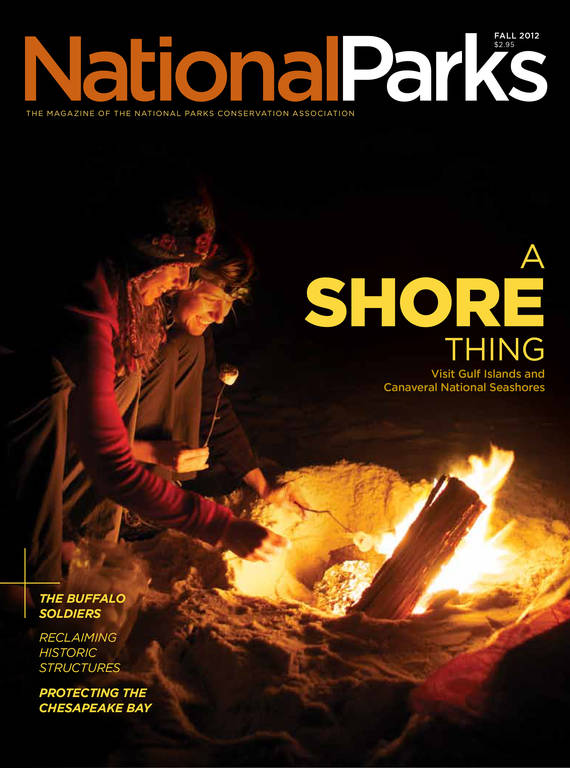Fall 2012
The Secret Lives of Hummingbirds
Scientists and volunteers shed light on some of the most colorful and charismatic species in the national parks.
Sparkling like a disco ball in the morning light of Mesa Verde National Park, the suspended globe of sugar water looks like an ordinary hummingbird feeder. Except this one has a net affixed to the top, and when a tiny aerialist lands on the perch, the woman standing nearby pulls a drawcord and—poof!—the bird is trapped within a soft, meshy balloon.
Netting birds is the first step in banding and tracking many songbirds and other bird species, but when biologists at Mesa Verde netted hummingbirds by accident, they had to let them go. “We just weren’t prepared to deal with them,” explains George San Miguel, the park’s natural resource manager, who points out their toothpick-sized legs, which challenged many surveying programs. Enter the Hummingbird Monitoring Network, which has trained park staff and volunteers how to handle the fragile creatures and also introduced a standard banding protocol, allowing several national parks to study populations that had long gone untracked.
TWO FOR ONE
Hummingbirds should be the most scrutinized creatures on Earth. These flying aces swoop backwards, straight up and down, and even side to side at speeds of 30 miles per hour. They’re the only birds that truly hover, their tiny wings beating up to 220 times a second.
But migratory details about hummingbird populations still remain a mystery. In 2002, the Hummingbird Monitoring Network (HMN) started a coordinated program to track the birds’ comings and goings and better understand this continental phenomenon. By recruiting volunteers to execute the banding protocols developed by HMN scientists, the network kicked off the first-ever long-term coordinated inquiry into the lives and migrations of these birds—and it’s relying on national parks to help fill in the details.
In 2003, Chiricahua National Monument, Coronado National Memorial, and Tumacacori National Historical Park in Arizona partnered with the HMN to create monitoring sites that trap, band, and release hummingbirds from March to October; low populations and administrative issues led them to drop out. Today seven national parks conduct HMN projects, including Mesa Verde in Colorado, Bryce Canyon in Utah, and Bandelier and Capulin Volcano National Monuments in New Mexico, which both joined the ranks this summer.
Park Service employees oversee the projects, but most of the work—from scrubbing and refilling bait stations to identifying each handled species—is done by volunteers. Every two weeks, a team arrives at dawn to begin its count. Some volunteers trap the birds while others identify the species, record fat levels and other indicators of overall health, note whether the bird carries an egg, and attach the tiny tracking band. “Our volunteers are motivated by the feeling that this program will yield some very interesting secrets about the hummingbirds of North America,” says San Miguel. Ideally, unveiling some of those secrets will help park managers understand the factors most critical to hummingbird conservation.
And that’s valuable information, as global warming threatens to push certain species out of their traditional hangouts. For example, rising temperatures may force broad-tailed hummingbirds into altitudes beyond Mesa Verde’s highest elevations (topping out at 8,640 feet), crowding them into a smaller land area and potentially exiling them from the park. Increasing development also may threaten hummingbirds by eliminating food sources and critical rest stops between their North American nesting grounds and winter homes in Mexico. By understanding where hummingbirds roam and what affects them along the way, land managers can make decisions that protect these species.
“It’s been a valuable partnership,” says Susan Wethington, a biologist who founded the Hummingbird Monitoring Network. Park units, she points out, are located in a variety of habitats and elevations that offer useful study sites. And compared with private properties, where changes in ownership can disrupt long-term studies, national parks offer the promise of sustained management.

National Parks
You can read this and other stories about history, nature, culture, art, conservation, travel, science and more in National Parks magazine. Your tax-deductible membership donation of $25 or more entitles…
See more ›“The longer the study, the more valuable it is,” says San Miguel, who bands hummingbirds himself. Periodic sampling “is just a snapshot,” he explains—the program can’t count and identify every bird that passes through the park. But by stitching those snapshots together over multiple years, biologists can discern patterns in hummingbird breeding, feeding, and migration habits. At Mesa Verde, for example, some banded birds have returned five years in a row.
Bryce Canyon presents a smaller snapshot, because the numbers of hummingbirds there have been lower than expected, suggesting that this park may sit some distance from major migration paths. But even the absence of traffic adds to scientists’ understanding of hummingbird distribution and the forces affecting it.
The monitoring program also creates an opportunity for public outreach and ignites visitors’ imaginations. “Hummingbirds show a lot of personality,” says Bryce’s park biologist Sarah Haas. “The program links people’s interest in hummingbirds to more complex issues, like climate change.” By pairing scientific research with education and interpretation, parks help grow the number of hummingbird advocates and ensure that these tiny aerialists continue to thrive.



